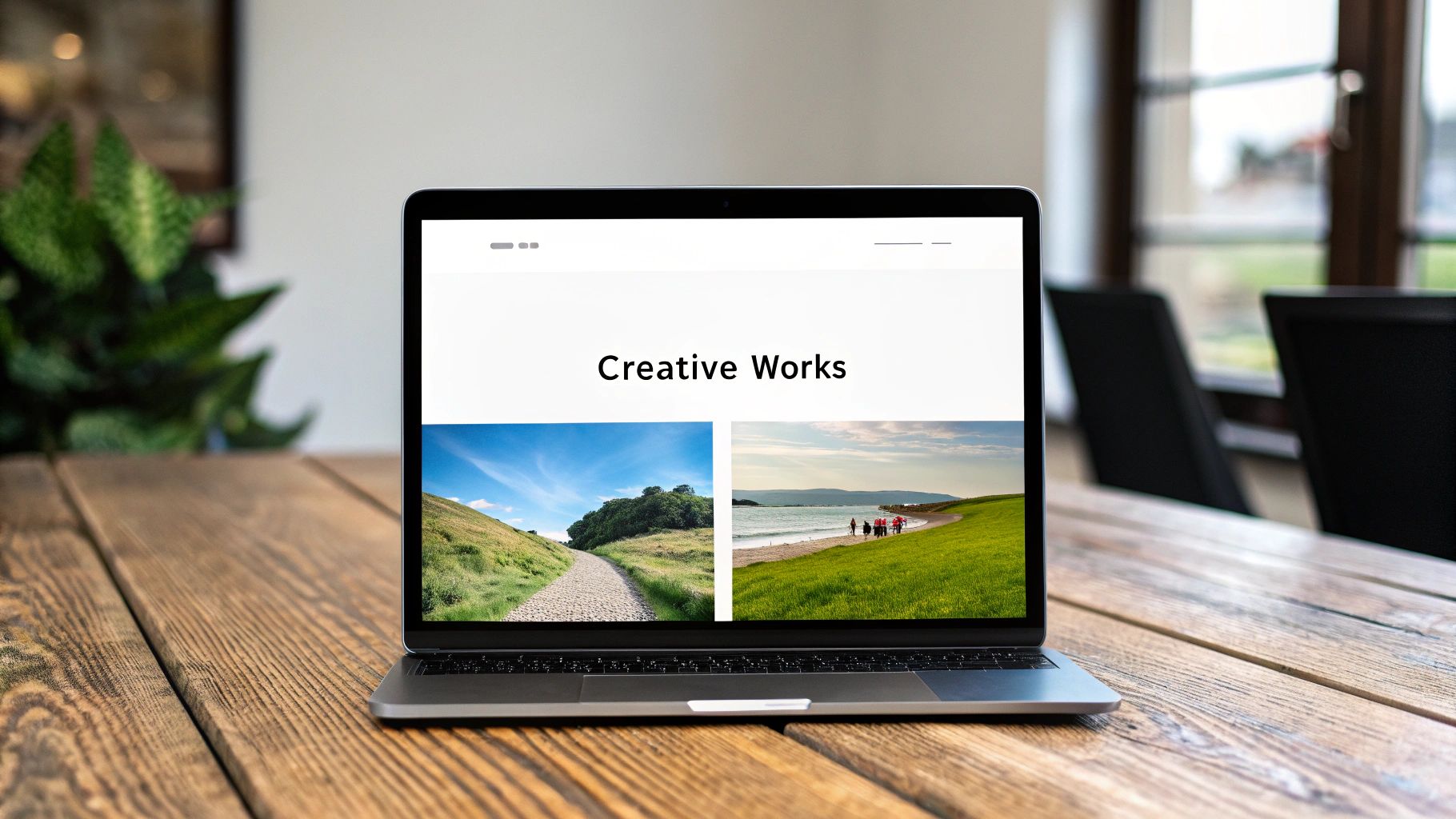21 March 2025

Why Your Digital Presence Demands a Personal Branding Website

In today's interconnected professional world, a robust online presence is essential for success. Think of your digital footprint as your professional storefront. Social media platforms like LinkedIn and Instagram act as valuable display windows, offering glimpses into your skills and experience. However, they lack the depth and control of a dedicated personal branding website.
A personal branding website serves as your central online hub, allowing you to fully showcase your expertise and create a lasting impression. Imagine a potential client or employer wants to delve deeper after seeing your LinkedIn profile. A well-designed website gives them a comprehensive view of your accomplishments, insights, and unique perspective, fostering stronger connections.
Social media platforms operate under their own algorithms and advertising structures. Your online presence is subject to their constant changes, potentially limiting your reach and influencing how your brand is perceived. Essentially, you're building on rented land. A personal branding website, however, grants you complete ownership and control.
The Growing Importance of Personal Branding
The concept of personal branding itself has become significantly more important in recent years. Platforms like LinkedIn and TikTok have amplified the need for individuals to cultivate and manage their online image. Searches for "personal brand" have increased more than fourfold, highlighting the growing recognition of its significance. LinkedIn reports that users with complete profiles are 40 times more likely to receive opportunities. This shift underscores that personal branding isn't just a competitive edge anymore – it's a necessity. For more statistics on personal branding, check out this resource: Personal Branding Statistics.
Leveraging Your Website as Your Digital Hub
Savvy professionals understand their personal branding website acts as their digital headquarters. They use social media profiles as satellite offices – crucial for visibility and outreach, but secondary to the main hub. This strategic approach offers several key advantages:
-
Control over your messaging: Craft a compelling narrative that reflects your unique skills and experience.
-
Enhanced credibility and authority: A well-structured website instantly projects professionalism, positioning you as a thought leader.
-
Improved search engine visibility: Optimizing your site with relevant keywords ensures you're easily found by potential clients and collaborators.
-
Direct lead generation: Incorporate calls to action and lead capture forms to generate new opportunities.
A personal branding website is a crucial investment in your future. It empowers you to control your narrative, connect with your audience, and cultivate a lasting brand presence. Building this digital headquarters is the first step towards establishing true authority and achieving long-term career success.
Core Elements That Make Personal Branding Websites Convert

Having a personal branding website is essential. But simply having a website isn't enough. An effective personal branding website needs to convert. It should turn visitors into clients, collaborators, or employers. This means understanding the key components that encourage engagement and action.
Homepage: Making A Powerful First Impression
Your homepage is the first thing visitors see. It’s your digital handshake and your elevator pitch rolled into one. It needs to communicate your value proposition quickly and clearly. A cluttered homepage can lead to high bounce rates, meaning visitors leave before exploring your site further.
A strong homepage should clearly state who you are and what you do. It should showcase your unique expertise and value. High-quality visuals that reflect your brand are also a must. Finally, a clear call to action is essential, guiding visitors toward your desired outcomes.
A consultant, for instance, might include a button inviting visitors to book a free consultation. A writer could showcase recent publications and invite subscriptions to their newsletter.
About Page: Building Genuine Connection
Your about page goes beyond a simple introduction. It's where you connect with your audience on a personal level. Share your story, motivations, and the values behind your work. This humanizes your brand and builds trust.
A compelling about page tells a story that resonates with your target audience. It highlights your unique background and experiences. Showcase your personality and passions. Explain how your skills and expertise benefit others.
Don't just list your resume. Inject personality into your narrative! Share anecdotes that illustrate your values and demonstrate your expertise. This helps build trust and authenticity.
Portfolio: Showcasing Your Capabilities
A strong portfolio is crucial. It showcases your abilities and demonstrates your value. Carefully curate this section to highlight your best work. Align your portfolio with your target audience’s needs. Think of it as a visual representation of your expertise.
An effective portfolio features high-quality examples of your work. Include detailed descriptions of each project. Showcase the results you've achieved for previous clients. Make it easy to navigate and visually appealing.
A designer might showcase their best designs, while a writer might feature compelling articles. The key is to present your work in a way that is both informative and engaging.
Design And Technical Elements: Enhancing User Experience
Content is king, but design and technical elements matter too. A visually appealing and user-friendly website enhances the overall experience. This encourages visitors to explore further. This includes everything from color psychology and typography to website speed and mobile responsiveness.
Key design and technical considerations include mobile responsiveness. Your website should function seamlessly across all devices. Website speed is also important. Optimize your site for quick loading. Clear navigation helps visitors find the information they need. And a visually appealing design uses colors, fonts, and images to create a positive user experience.
To help illustrate the essential elements, the table below provides a quick overview of the must-have components of a personal branding website:
Essential Elements of a Personal Branding Website
This table outlines the must-have components for an effective personal branding website, their purpose, and implementation recommendations.
| Website Element | Purpose | Implementation Tips |
|---|---|---|
| Homepage | First impression, value proposition | Clear messaging, strong visuals, call to action |
| About Page | Build connection, share your story | Personal narrative, highlight experience and values |
| Portfolio | Showcase capabilities, demonstrate value | High-quality examples, detailed descriptions, results-oriented |
| Design & Technical Elements | Enhance user experience, encourage exploration | Mobile responsive, fast loading, clear navigation, visually appealing |
This table summarizes the key elements for a successful personal branding website. By addressing each of these areas, you can create a site that effectively converts visitors into opportunities.
By focusing on these core elements, you can create a dynamic platform. Your website becomes more than just an online presence. It's a powerful tool for building your brand, connecting with your audience, and achieving long-term success.
Turning Your Personal Branding Website Into a Revenue Engine

Your personal branding website should be more than just an online resume. It should actively generate opportunities and revenue. This involves strategically designing your site to attract visitors and convert them into clients, collaborators, or even employers. How can you achieve this without seeming overly promotional? By offering genuine value and strategically incorporating calls to action.
Crafting Compelling Calls to Action
The design, placement, and wording of your calls to action (CTAs) are critical. Consider them guideposts directing visitors toward your desired outcomes. Instead of generic phrases like "Contact Me," use specific wording that reflects the value you provide. For instance, a consultant might use "Book a Free Consultation," while a designer could use "View My Portfolio."
Visually, your CTAs should be attractive and easily distinguishable from the surrounding content. Use contrasting colors and eye-catching visuals to draw attention. A/B testing different CTAs can also help determine what resonates best with your target audience.
Leveraging Testimonials and Social Proof
Building trust is essential for conversions. Incorporate testimonials and social proof throughout your website. Showcase positive client feedback, colleague endorsements, or recommendations from industry leaders to highlight your expertise and build confidence.
Feature testimonials prominently on your homepage and service pages. Include headshots and relevant credentials for added authenticity. If you're a business coach, showcasing testimonials from clients who experienced significant growth under your guidance can be particularly effective.
Measuring Your Site’s Business Impact
To truly understand your website's contribution to your revenue, tracking the right metrics is vital. Focus on key performance indicators (KPIs) that align with your business objectives. These could include website traffic, lead generation, conversion rates, or sales directly generated from your site.
Use analytics tools like Google Analytics to monitor website performance. Track popular pages, visitor sources, and time spent on your site. This data provides valuable insights into what's working and areas for improvement.
Creating Content Funnels for Conversion
Consider developing content funnels that guide visitors towards becoming clients or customers. Start by offering valuable free content, like blog posts or videos, addressing your audience's pain points.
Then, offer more in-depth resources, such as ebooks or webinars, in exchange for contact information. Nurture those leads with targeted email campaigns and relevant offers. This establishes a clear path from initial engagement to conversion. When employees share brand messages on social media, they achieve 561% more reach than brand channels. This highlights the power of personal branding. Learn more: Statistics on the Power of Personal Branding.
By implementing these strategies, your personal branding website transforms into a powerful tool for generating revenue and achieving your business goals.
Content Strategies That Establish True Authority

A polished design is just the starting point for a compelling personal branding website. Truly effective sites offer high-quality content that positions you as an authority in your field. This doesn't mean creating an overwhelming amount of content. Instead, focus on strategic content that truly resonates with your target audience and showcases what makes you unique.
Understanding Your Audience’s Pain Points
Before you write a single word, take the time to understand your audience. What challenges and needs do they have? What problems are they trying to solve? By directly addressing these pain points with your content, you position yourself as a valuable resource and build trust. For instance, a business coach could create content offering practical advice on improving team productivity or managing difficult client interactions.
Content Formats for Maximum Impact
Different content formats offer unique advantages. Blog posts are great for sharing in-depth insights and driving organic traffic to your website. Videos offer a more personal touch and highlight your communication style. Infographics and data visualizations present complex information clearly and concisely. Experiment to see which formats resonate best with your audience.
To help illustrate the different options and their benefits, take a look at the comparison table below:
To provide a clearer picture, let's compare different content formats:
Content Types for Personal Branding Websites – a comparison of different content formats, their benefits, creation difficulty, and audience impact.
| Content Type | Key Benefits | Creation Difficulty | Audience Impact |
|---|---|---|---|
| Blog Posts | SEO benefits, in-depth information | Moderate | High reach, builds authority |
| Videos | Personal connection, engaging format | Moderate to High | Strong engagement, builds trust |
| Infographics | Concise presentation of data, visually appealing | Moderate | Easy to share, increases visibility |
| Case Studies | Demonstrates expertise, provides real-world examples | High | Builds credibility, attracts clients |
This table provides a quick overview of how different formats can contribute to your overall content strategy. Consider the resources you have available and the preferences of your target audience when selecting which formats to prioritize.
Consistent Publishing and Repurposing Content
A consistent publishing schedule keeps your audience engaged and reinforces your authority. But, consistency shouldn't compromise quality. Repurposing content across multiple platforms is a highly effective strategy. A single blog post, for example, can be broken down into social media updates, an infographic, or even a short video. This expands your reach without demanding constant content creation.
Content Planning for Busy Professionals
Creating a realistic content plan is essential, especially for busy professionals. Begin by outlining key topics related to your area of expertise. Next, build a content calendar specifying publishing dates and formats. Batch-creating content is a time-saving technique that helps maintain consistency. This organized process ensures you deliver value to your audience without feeling overwhelmed. A consistent flow of valuable content helps your personal branding website continually attract and engage your target audience.
By implementing these content strategies, your personal branding website becomes a powerful tool. It showcases your expertise, connects with your target audience, and ultimately establishes you as a respected voice in your chosen field.
Future-Proofing Your Personal Branding Website
Building a personal branding website is a crucial first step. But to make sure it stays effective, you need to adapt to the ever-changing online world. This means understanding which new technologies genuinely improve your online presence, and which are just temporary distractions. In other words, you need to future-proof your site.
Embracing AI-Enhanced Personalization
Artificial intelligence (AI) offers exciting new ways to personalize the user experience. Think about using AI-powered chatbots. They can instantly answer visitor questions, saving you time and improving user experience. AI can also personalize content recommendations, showing visitors the most relevant information based on their interests and past behavior. This creates a more engaging and tailored experience for everyone.
The Power of Video Integration
Video isn't just an extra anymore; it's a central part of effective online communication. Adding video to your personal branding website can significantly increase engagement. You could include a video introduction on your homepage, video testimonials from happy clients, or even short video explanations of your services. These additions make your brand more relatable and create a more dynamic experience for visitors.
Building With Flexible Frameworks
The framework you choose for your website can have a huge impact on its long-term success. Choose flexible frameworks that are easy to update and adapt. This will save you time and money in the long run. A website built on a rigid platform may need major rebuilds as technology advances. Rebuilds can be expensive and time-consuming, especially for solopreneurs or those with limited technical skills.
Staying Ahead of the Curve
The online world is constantly changing. Staying informed about emerging trends is crucial for future-proofing your site. But it's important to separate truly impactful technologies from passing fads. The future of personal branding is heavily influenced by advances like AI and the increasing popularity of video-first platforms. For example, AI is being used for content creation and personalized experiences, while the growth of video highlights the need for high-quality visual content. Discover more insights about future personal branding trends here: The Future of Personal Branding: Trends To Watch. Focus on using tools and strategies that truly add value to your brand and connect with your audience.
Prioritizing Accessibility and Inclusivity
Future-proofing also means making sure your website is accessible to everyone. Add accessibility features, such as alt text for images and keyboard navigation, to make your site usable for people with disabilities. This not only expands your audience but also shows your commitment to inclusivity, a value that is increasingly important to people today.
By using these strategies, you can ensure your personal branding website remains a powerful tool. It will adapt to the ever-changing digital landscape while continuing to attract and engage your target audience. Your website becomes a dynamic platform, not just showing who you are now, but growing and evolving along with your career.
Carving Your Niche Through Personal Branding
A strong personal brand is essential for success in today's competitive world. However, true success often comes from specializing. This means identifying and owning a specific niche within your broader professional field. Think of it as a magnifying glass focusing sunlight: a broad beam is diffuse, while a concentrated beam generates intense heat. Similarly, a broadly defined brand may not have the same impact as one deeply rooted in a specific area of expertise. This section explores how to identify a profitable niche and showcase it effectively on your personal branding website.
Identifying Your Niche: Where Passion Meets Profit
Finding your niche involves combining what you're good at with what the market needs. Begin by considering your skills and interests. What genuinely excites you? What problems can you solve better than anyone else? For example, a marketing consultant might be passionate about helping small businesses grow. This passion could lead them to specialize in providing affordable digital marketing strategies to startups.
Next, research your target market. Are there enough people or businesses seeking solutions in your chosen area? Look for underserved segments where your specialized skills can make a real difference. Pinpointing a profitable niche requires self-reflection paired with thorough market research. This ensures your passion aligns with a genuine need in the marketplace.
Validating Your Niche: Testing the Waters
Before fully committing to a niche, validate its viability. Reach out to potential clients or customers within your target audience. Conduct surveys or informational interviews to gather feedback on their pain points and unmet needs. This direct engagement helps ensure there's actual demand for your specialized services. It also provides valuable insights to refine your offerings based on real-world feedback.
Expressing Your Niche: Weaving it into Your Website
Once you've identified and validated your niche, it's essential to integrate it into your personal branding website. Your homepage, about page, and portfolio should clearly communicate your area of focus. Use relevant keywords related to your niche throughout your website copy and content. This will attract the right audience and position you as a specialist in your chosen field. Showcasing client testimonials or case studies specific to your niche builds credibility and demonstrates the value you provide.
Focusing on micro niches has become increasingly important for generating revenue. This involves targeting a very specific audience with highly tailored solutions. Creators build dedicated communities and monetize their expertise more effectively using platforms like Patreon and Substack. This targeted approach fosters stronger connections, leading to higher engagement and brand loyalty. Learn more about micro niches and personal branding: Explore Micro Niches in Personal Branding.
Balancing Specialization with Adaptability
While specialization is key, it's also important to remain adaptable. Markets and personal interests change over time. Design your website with flexibility in mind. Choose a website platform and structure that allows for easy content updates and modifications to your services. This ensures your brand remains relevant and continues to attract new opportunities as you evolve professionally. Carving a niche strengthens your brand, allowing you to establish greater authority and access more valuable opportunities within your field.
Ready to amplify your personal brand and define your niche with a powerful website? Supersonify empowers individuals like influencers, executives, and consultants to create compelling online presences. Let Supersonify help you define your unique value and achieve lasting impact.




